Carl Zeiss AG
Carl Zeiss AG (German: [kaʁl tsaɪs]),[3][4] branded as ZEISS, is a German manufacturer of optical systems and optoelectronics, founded in Jena, Germany in 1846 by optician Carl Zeiss. Together with Ernst Abbe (joined 1866) and Otto Schott (joined 1884) he laid the foundation for today's multi-national company. The current company emerged from a reunification of Carl Zeiss companies in East and West Germany with a consolidation phase in the 1990s.[5] ZEISS is active in four business segments with approximately equal revenue, Industrial Quality and Research, Medical Technology, Consumer Markets and Semiconductor Manufacturing Technology in almost 50 countries, has 30 production sites and around 25 development sites worldwide.[6]
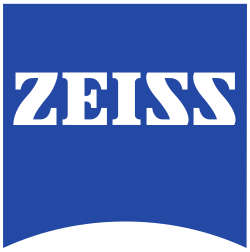 | |
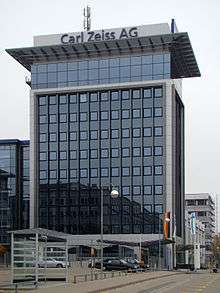 Carl Zeiss AG headquarters in Oberkochen | |
| Aktiengesellschaft | |
| Industry | Imaging |
| Founded | Jena, Germany 1846 |
| Founder | Carl Zeiss |
| Headquarters | Oberkochen, Germany |
Key people | Karl Lamprecht,[1] CEO and President |
| Products | Semiconductor lithography equipment, light, electron and ion microscopes, coordinate-measuring machines, medical devices, eyeglasses, binoculars, spotting scopes, telescopes, planetarium projectors, and other optical equipment. |
| Revenue | |
Number of employees | |
| Parent | Carl-Zeiss-Stiftung |
| Website | www |
Carl Zeiss AG is the holding of all subsidiaries within Zeiss Group, of which Carl Zeiss Meditec AG is the only one that is traded at the stock market. Carl Zeiss AG is owned by the foundation Carl-Zeiss-Stiftung. The Zeiss Group has its headquarters in southern Germany, in the small town Oberkochen with its second largest and founding site being Jena in eastern Germany. Also controlled by the Carl-Zeiss-Stiftung is the glass manufacturer Schott AG, located in Mainz and Jena. Carl Zeiss is one of the oldest existing optics manufacturers in the world.[7]
Corporate history
.jpg)
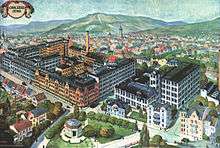
_2.jpg)
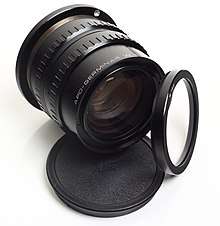
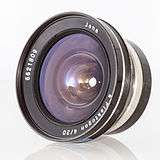
Carl Zeiss opened an optics workshop in Jena in 1846. By 1847 he was making microscopes full-time. By 1861 the Zeiss workshop was considered to be among the best scientific-instrument makers in Germany with about 20 people working in the company, and business growing quickly. By 1866 Zeiss sold their 1,000th microscope. In 1872 physicist Ernst Abbe joined Zeiss and along with Otto Schott designed greatly improved lenses for the optical instruments they were producing. After Carl Zeiss's death in 1888, the business was incorporated as the Carl-Zeiss-Stiftung in 1889.
By World War I,[8] Zeiss was the world's largest location of camera production. Zeiss Ikon represented a significant part of the production along with dozens of other brands and factories, and also had major works at Dresden.
In 1928 Hensoldt AG was acquired by Carl Zeiss and has produced the Zeiss binoculars and riflescopes since 1964,[9] occasionally resulting in twin products being offered under both the Hensoldt and Zeiss brand names. The Hensoldt System Technology division (resulting from a merger of the military optics operations of Leica and Hensoldt) was continued by Zeiss under the Hensoldt name until 2006.
As part of Nazi Germany Zwangsarbeiter program, Zeiss used forced labour during World War II.[10][11] The destruction of the war caused many companies to divide into smaller subcompanies and others to merge. There was great respect for the engineering innovation that came out of Dresden—before the war the world's first 35 mm single-lens reflex camera, the Kine Exakta, and the first miniature camera with good picture quality were developed there.
At the end of the war, Jena was occupied by the United States Army. When Jena and Dresden were incorporated into the Soviet occupation zone, later East Germany, some parts of Zeiss Jena were relocated by the US army to the Contessa manufacturing facility in Stuttgart, West Germany, while the remainder of Zeiss Jena was reestablished by the (eastern) German Democratic Republic as Kombinat VEB Zeiss Jena.[12] The Soviet Army took most of the existing Zeiss factories and tooling as World War II spoils back to the Soviet Union, establishing the Kiev camera works.
The western business was restarted in Oberkochen, southwestern Germany, as Opton Optische Werke Oberkochen GmbH in 1946, which became Zeiss-Opton Optische Werke Oberkochen GmbH in 1947, but was soon renamed to Carl Zeiss. West German Zeiss products were labelled Opton for sale in the Eastern bloc, while East German Zeiss products were labelled "Zeiss Jena" or simply "Jena" for sale in Western countries.
In 1973, the Western Carl Zeiss AG entered into a licensing agreement with the Japanese camera company Yashica to produce a series of high-quality 35 mm film cameras and lenses bearing the Contax and Zeiss brand names. This collaboration continued under Yashica's successor, Kyocera, until the latter ceased all camera production in 2005. Zeiss later produced lenses for the space industry and, more recently, has again produced high-quality 35 mm camera lenses. The eastern Zeiss Jena was also well known for producing high-quality products.
Following German reunification, VEB Zeiss Jena — reckoned as one of the few East German firms that was even potentially able to compete on a global basis — became Zeiss Jena GmbH, which became Jenoptik Carl Zeiss Jena GmbH in 1990. In 1991, Jenoptik Carl Zeiss Jena was split in two, with Carl Zeiss AG (Oberkochen) taking over the company's divisions for microscopy and other precision optics (effectively reuniting the pre-war Carl Zeiss enterprise) and moving its microscopy and planetarium divisions back to Jena. Jenoptik GmbH was split off as a specialty company in the areas of photonics, optoelectronics, and mechatronics.[13][14]
The Hensoldt AG was renamed Carl Zeiss Sports Optics GmbH on 1 October 2006.[15]
The companies of the Zeiss Gruppe in and around Dresden have branched into new technologies: screens and products for the automotive industry, for example.
Today, there are arguably three companies with primarily Zeiss Ikon heritage: Zeiss Germany, the Finnish/Swedish Ikon (which bought the West German Zeiss Ikon AG), and the independent eastern Zeiss Ikon.
A division called Carl Zeiss Vision produces lenses for eyeglasses.[16] In 2005, the eyeglass division merged with U.S. company SOLA, which included the former American Optical Company.[17][18]
On 28 June 2013, Carl Zeiss officially announced its plan to rename the brand from "Carl Zeiss" to simply "Zeiss". All the products will be standardized under the Zeiss brand.[19]
In April 2019, Zeiss announced the acquisition of Braunschweig-based GOM.[20]
Innovations
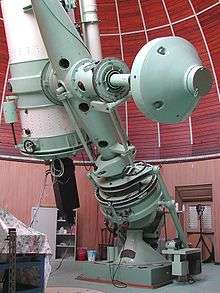

The Zeiss company was responsible for many innovations in optical design and engineering in each of their major fields of business. Today this becomes exemplarily visible in the latest EUV lithography systems, the equipment needed to produce the latest generations of semiconductor components. It also includes early high-performance optical microscopes up to today's electron and ion microscopes, which reach a sub-nanometers resolution. It includes technology leadership in the first surgical microscopes and ophthalmic devices. It also includes high-performance contact metrology systems. For many years Zeiss showed innovations in fields as astronomical telescopes, photographic and cinematic lenses.
Early on, Carl Zeiss realised that he needed a competent scientist so as to take the firm beyond just being another optical workshop. In 1866, the service of Dr. Ernst Abbe was enlisted. From then on novel products appeared in rapid succession which brought the Zeiss company to the forefront of optical technology.
Abbe was instrumental in the development of the famous Jena optical glass. When he was trying to eliminate stigmatism from microscopes, he realized that the range of optical glasses available was insufficient. After some calculations, he realised that performance of optical instruments would dramatically improve if optical glasses of appropriate properties were available. His challenge to glass manufacturers was finally answered by Dr. Otto Schott, who established the famous glassworks at Jena from which new types of optical glass began to appear from 1888 to be employed by Zeiss and other makers.
The new Jena optical glass also opened up the possibility of increased performance of photographic lenses. The first use of Jena glass in a photographic lens was by Voigtländer, but as the lens was an old design its performance was not greatly improved. Subsequently, the new glasses would demonstrate their value in correcting astigmatism, and in the production of apochromatic lenses. Abbe started the design of a photographic lens of symmetrical design with five elements, but went no further.
Zeiss' domination of photographic lens innovation was due to Dr Paul Rudolph. In 1890, Rudolph designed an asymmetrical lens with a cemented group at each side of the diaphragm, appropriately named "Anastigmat". This lens was made in three series: Series III, IV and V, with maximum apertures of f/7.2, f/12.5, and f/18 respectively. In 1891, Series I, II and IIIa appeared with respective maximum apertures of f/4.5, f/6.3, and f/9 and in 1893 came Series IIa of f/8 maximum aperture. These lenses are now better known by the trademark "Protar", which was first used in 1900.
At the time, single combination lenses, which occupy one side of the diaphragm only, were still popular. Rudolph designed one with three cemented elements in 1893, with the option of fitting two of them together in a lens barrel as a compound lens, but it was found to be the same as the Dagor by C.P. Goerz, designed by Emil von Hoegh. Rudolph then came up with a single combination with four cemented elements, which can be considered as having all the elements of the Protar stuck together in one piece. Marketed in 1894, it was called the Protarlinse Series VII, the most highly corrected single combination lens with maximum apertures between f/11 and f/12.5, depending on its focal length.
But the important thing about this Protarlinse is that two of these lens units can be mounted in the same lens barrel to form a compound lens of even greater performance and a larger aperture, between f/6.3 and f/7.7. In this configuration, it was called the Double Protar Series VIIa. An immense range of focal lengths can thus be obtained by the various combination of Protarlinse units.
Rudolph also investigated the Double-Gauss concept of a symmetrical design with thin positive menisci enclosing negative elements. The result was the Planar Series Ia of 1896, with maximum apertures up to f/3.5, one of the fastest lenses of its time. Whilst it was very sharp, it suffered from coma which limited its popularity. However, further developments of this configuration made it the design of choice for high-speed lenses of standard coverage.
Probably inspired by the Stigmatic lenses designed by Hugh Aldis for Dallmeyer of London, Rudolph designed a new asymmetrical lens with four thin elements, the Unar Series Ib, with apertures up to f/4.5. Due to its high speed, it was used extensively on hand cameras.
The most important Zeiss lens by Rudolph was the Tessar, first sold in 1902 in its Series IIb f/6.3 form. It can be said as a combination of the front half of the Unar with the rear half of the Protar. This proved to be the most valuable and flexible design, with tremendous development potential. Its maximum aperture was increased to f/4.7 in 1917 and reached f/2.7 in 1930. It is probable that every lens manufacturer has produced lenses of the Tessar configurations.
Rudolph left Zeiss after World War I, but many other competent designers such as Merté, Wandersleb, etc. kept the firm at the leading edge of photographic lens innovations. One of the most significant designers was the ex-Ernemann man Dr Ludwig Bertele, famed for his Ernostar high-speed lens.
With the advent of the Contax by Zeiss-Ikon, the first professional 35mm system camera became available. At this stage the Leica was no more than a convenient and portable snapshot camera. However Leitz could see the potential offered by the Contax and rapidly developed a coupled rangefinder and started to introduce additional lenses. As a system camera there was a need for a range of lenses for the Contax. Bertele's Sonnar series of lenses designed for the Contax was the match in every respect for the Leica for at least two decades. Other lenses for the Contax included the Biotar, Biogon, Orthometar, and various Tessars and Triotars.
The last important Zeiss innovation before World War II was the technique of applying an anti-reflective coating to lens surfaces invented by Olexander Smakula in 1935.[21] A lens so treated was marked with a red "T", short for "Transparent". The technique of applying multiple layers of coatings was developed from this basis after the war, and known as "T✻" (T-star).[22]
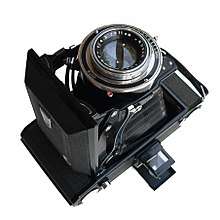
After the partitioning of Germany, a new Carl Zeiss optical company was established in Oberkochen, while the original Zeiss firm in Jena continued to operate. At first, both firms produced very similar lines of products, and extensively cooperated in product-sharing, but they drifted apart as time progressed. Jena's new direction was to concentrate on developing lenses for 35 mm single-lens reflex cameras, and many achievements were made, especially in ultra-wide angle designs. In addition to that, Oberkochen also worked on designing lenses for the 35 mm single-lens reflex camera Contarex, for the medium format camera Hasselblad, for large format cameras like the Linhof Technika, interchangeable front element lenses such as for the 35 mm single-lens reflex Contaflex and other types of cameras.
Since the beginning of Zeiss as a photographic lens manufacturer, it has had a licensing programme, allowing other manufacturers to produce its lenses. Over the years its licensees included Voigtländer, Bausch & Lomb, Ross, Koristka, Krauss, Kodak. etc. In the 1970s, the western operation of Zeiss-Ikon collaborated with Yashica to produce the new Contax cameras, and many of the Zeiss lenses for this camera, among others, were produced by Yashica's optical arm, Tomioka. As Yashica's owner Kyocera ended camera production in 2006, and Yashica lenses were then made by Cosina, who also manufactured most of the new Zeiss designs for the new Zeiss Ikon coupled rangefinder camera. Another licensee active today is Sony who uses the Zeiss name on lenses on its video and digital still cameras.
Business relationships
Zeiss has licensed its name and/or technology to various other companies, including Hasselblad, Rollei, Yashica, Sony, Logitech, and Alpa. The nature of the collaboration varies, from co-branding optics designed by another firm (e.g., Sony) to complete optical design and manufacturing (e.g., Hasselblad).
On 27 April 2005, the company announced a collaboration with Nokia in the camera phone market, with Zeiss providing camera optics. Zeiss will again provide optics for Nokia products through a collaboration with HMD Global announced on 6 July 2017.[24]
Zeiss cameras
Zeiss ZX digital cameras
The Zeiss ZX1 full-frame 35mm F/2 large-sensor compact camera was announced during Photokina 2018 with the slogan 'Shoot – Edit – Share'. The camera incorporates Adobe editing capacities, and an internal 512GB SSD affording 6,800 DNG-format RAW images or 50,000 JPEG-format compressed images.[25]
Zeiss Ikon film cameras
Zeiss Ikon is a camera brand related to Carl Zeiss, but was an independent company formed by the merger of four camera makers (Contessa-Nettel, Ernemann, Goerz and Ica) in 1926. Much of the capital came from Zeiss which also provided most of the lenses and shutters for the cameras. Among the founders was August Nagel of Contessa-Nettel, who left the company in 1928 to form the Nagel Works, and in 1932, his company was bought by Kodak. After World War II, Japanese Nippon Kogaku offered the "Nikon" camera, and Zeiss Ikon prevented some European distribution under the theory that "Nikon" was an infringement on their brand name.
The earliest Zeiss Ikon cameras were a range of medium and large format folding cameras, for film and glass plate photography. The most expensive was the Universal Juwel (Jewel) an Ica-designed glass plate camera with origins in 1909. This was a favorite of both Ansel Adams and Dorothea Lange. Despite German production, the folding Super Ikonta was among the mainstays of British Army photographers during World War II.
In 1932 Zeiss Ikon introduced the Contax line of 35mm rangefinder cameras having recognised the potential for a system camera using 35mm film. The Contax I was introduced with a wide range of lenses and accessories for scientific and professional use. In 1936, an improved model the Contax II was introduced and became the favorite of many renowned photographers and journalists, including Robert Capa and Margaret Bourke-White. A second 35mm camera, the Contax III, was mechanically identical with a light meter grafted to the top of the camera.
After World War II, the Soviets removed the Contax factory to Kiev, as war reparations, and produced the Contax II and III cameras under the Kiev brand. The first Kiev cameras were identical except for logos. Zeiss Ikon were without designs or facilities for making the Contax and set about producing an improved replacement. These were named the Contax IIa and IIIa, and were smaller and lighter than the original designs. But by the time the IIa and IIIa hit the market, they faced strong competition from many European and Asian brands, notably the visually similar Nikon which was a high quality camera sharing the same lens-mount and most of the features.
By the mid-1950s, Zeiss Ikon was focusing on single-lens reflex cameras and while offering rangefinders, they were not adding features and became uncompetitive with Japanese brands including Canon, Yashica, Minolta, and Nikon. The Zeiss Ikon Contaflex single-lens reflex cameras were viable in the mid 1950s, but soon lost market share to the Japanese brands.
More recent 35mm rangefinder cameras are simply named "Zeiss Ikon." The most recent "Zeiss Ikon" rangefinder camera was an M mount camera with automatic exposure, introduced by Zeiss in 2004, manufactured in Japan by Cosina, and now discontinued.
Camera lenses
Cinema lenses
Carl Zeiss AG has long been renowned for its motion picture lenses. Zeiss manufactures prime and zoom lenses for 35mm, 16mm, and 65mm film production. They also make lenses for digital cinema and high definition video. Zeiss is mainly known in the trade for their association with the German camera manufacturer Arri for whom they currently produce lenses.
Current models of Zeiss cinema lenses are:
- Master Prime T✻XP Distagon 14 mm T1.3
- Master Prime T✻XP Distagon 16 mm T1.3
- Master Prime T✻XP Distagon 18 mm T1.3
- Master Prime T✻XP Distagon 21 mm T1.3
- Master Prime T✻XP Distagon 25 mm T1.3
- Master Prime T✻XP Distagon 27 mm T1.3
- Master Prime T✻XP Distagon 32 mm T1.3
- Master Prime T✻XP Distagon 35 mm T1.3
- Master Prime T✻XP Distagon 40 mm T1.3
- Master Prime T✻XP Planar 50 mm T1.3
- Master Prime T✻XP Planar 65 mm T1.3
- Master Prime T✻XP Sonnar 75 mm T1.3
- Master Prime T✻XP Sonnar 100 mm T1.3
- Master Prime T✻XP Sonnar 150 mm T1.3
- Master Zoom T✻XP 16.5–110 mm T2.6
- Master Macro T✻XP Makro-Planar 100 mm T2.0/T4.3
- Lightweight Zoom LWZ.2 T✻XP Vario-Sonnar 15.5–45 mm T2.6
- Ultra Prime 8R T✻ Distagon 8 mm T2.8
- Ultra Prime T✻ Distagon 10 mm T2.1
- Ultra Prime T✻ Distagon 12 mm T1.9
- Ultra Prime T✻ Distagon 14 mm T1.9
- Ultra Prime T✻ Distagon 16 mm T1.9
- Ultra Prime T✻ Distagon 20 mm T1.9
- Ultra Prime T✻ Distagon 24 mm T1.9
- Ultra Prime T✻ Distagon 28 mm T1.9
- Ultra Prime T✻ Distagon 32 mm T1.9
- Ultra Prime T✻ Distagon 40 mm T1.9
- Ultra Prime T✻ Planar 50 mm T1.9
- Ultra Prime T✻ Planar 65 mm T1.9
- Ultra Prime T✻ Planar 85 mm T1.9
- Ultra Prime T✻ Sonnar 100 mm T1.9
- Ultra Prime T✻ Sonnar 135 mm T1.9
- Ultra Prime T✻ Sonnar 180 mm T1.9
- Compact Prime CP.2 T✻ Distagon 18 mm T3.6
- Compact Prime CP.2 T✻XP Distagon 21 mm T2.9
- Compact Prime CP.2 T✻XP Distagon 25 mm T2.9
- Compact Prime CP.2 T✻XP Distagon 28 mm T2.1
- Compact Prime CP.2 T✻XP Distagon 35 mm T2.1
- Compact Prime CP.2 T✻XP Distagon 50 mm T2.1
- Compact Prime CP.2 T✻ Planar 50 mm T2.1 Macro
- Compact Prime CP.2 T✻ Planar 85 mm T2.1
- Compact Prime CP.2 T✻ Makro-Planar 100 mm T2.1 CF
- Ultra 16 T✻XP Distagon 6 mm T1.3
- Ultra 16 T✻XP Distagon 8 mm T1.3
- Ultra 16 T✻XP Distagon 9.5 mm T1.3
- Ultra 16 T✻XP Distagon 12 mm T1.3
- Ultra 16 T✻XP Distagon 14 mm T1.3
- Ultra 16 T✻XP Distagon 18 mm T1.3
- Ultra 16 T✻XP Distagon 25 mm T1.3
- Ultra 16 T✻XP Planar 35 mm T1.3
- Ultra 16 T✻XP Planar 50 mm T1.3
- DigiPrime T✻ 3.9 mm T1.9
- DigiPrime T✻ 5 mm T1.9
- DigiPrime T✻ 7 mm T1.6
- DigiPrime T✻ 10 mm T1.6
- DigiPrime T✻ 14 mm T1.6
- DigiPrime T✻ 20 mm T1.6
- DigiPrime T✻ 28 mm T1.6
- DigiPrime T✻ 40 mm T1.6
- DigiPrime T✻ 52 mm T1.6
- DigiPrime T✻ 70 mm T1.6
- DigiPrime T✻ 135 mm T1.9
- DigiZoom T✻ Vario-Sonnar 6–24 mm T1.9
- DigiZoom T✻ Vario-Sonnar 17–112 mm T1.9
Medium-format lenses
Carl Zeiss AG has produced lenses for Hasselblad[26] and Rollei cameras, including:
- CFi/CFE-Lenses for Hasselblad 500 (V System)
- F-Distagon T✻ 30mm ƒ/3.5
- Distagon T✻ 40mm ƒ/4
- Distagon T✻ 50mm ƒ/4
- Distagon T✻ 50mm ƒ/4 ZV
- Distagon T✻ 60mm ƒ/3.5
- Planar T✻ 80mm ƒ/2,8
- Planar T✻ 100mm ƒ/3.5
- Makro-Planar T✻ 120mm ƒ/4
- Makro-Planar T✻ 120mm ƒ/4 ZV
- Sonnar T✻ 150mm ƒ/4
- Sonnar T✻ 180mm ƒ/4
- Sonnar T✻ 250mm ƒ/5.6
- Tele-Superachromat T✻ 350mm ƒ/5,6
- FE-Lenses for Hasselblad 200
- Distagon T✻ 50mm ƒ/2,8 FE
- Planar T✻ 110mm ƒ/2 FE
- Hasselblad SWC Biogon 38mm ƒ/4.5
- Rollei 6000 system
- F-Distagon 30mm ƒ/3.5 HFT PQ
- Distagon 40mm ƒ/4 FLE HFT
- Distagon 50mm ƒ/4 FLE HFT
- Distagon 60mm ƒ/3.5 HFT PQ
- Planar 80mm ƒ/2.8 HFT PQS
- Planar 110mm ƒ/2 HFT PQ
- Sonnar 150mm ƒ/4 HFT PQS
- Sonnar 250mm ƒ/5.6 HFT PQS
- Makro-Planar 120mm ƒ/4 HFT PQS
- Rolleiflex TLR
- Tessar 75mm ƒ/3.5
- Planar 80mm ƒ/2.8
- Distagon 55mm ƒ/4
Large-format lenses
Zeiss has produced lenses for large format and press cameras, including:
- Tessar lenses (4 elements in 3 groups)
- Tessar 100mm ƒ/3.5 (6.5×9 cm format)
- Tessar 105mm ƒ/3.5 (6.5×9 cm fmt)
- Tessar 150mm ƒ/4.5 (9×12 cm fmt)
- Planar lenses (5 elements in 4 groups)
- Planar 80mm ƒ/2.8 (6×7 cm fmt)
- Planar 100mm ƒ/2.8 (6.5×9 cm fmt)
- Planar 135mm ƒ/3.5
- Planar 135mm ƒ/3.5 T✻
- Planar 150mm ƒ/2.8
- Sonnar lenses
- Sonnar 180mm ƒ/4.8
- Sonnar 250mm ƒ/5.6
Zeiss has departed the large-format optics field along with Nikon, leaving Schneider and Rodenstock as the primary makers of such lenses today.
ZM lenses
Zeiss ZM lenses fit Leica M mount cameras, including Leica M series, the Ricoh GXR A12, and many mirrorless interchangeable-lens cameras through the use of adapters. Some ZM lenses are manufactured in Germany by Zeiss, others in Japan by Cosina. Lenses designated "C" are considered compact or classic lenses.
- Distagon T✻ 15mm ƒ/2.8 (Made in Germany)
- Distagon T✻ 18mm ƒ/4
- Distagon T✻ 21mm ƒ/2.8
- C Biogon T✻ 21mm ƒ/4.5
- Biogon T✻ 25mm ƒ/2.8
- Biogon T✻ 28mm ƒ/2.8
- Biogon T✻ 35mm ƒ/2
- C Biogon T✻ 35mm ƒ/2.8
- C Sonnar T✻ 50mm ƒ/1.5
- Planar T✻ 50mm ƒ/2
- Tele-Tessar T✻ 85mm ƒ/4
- Sonnar T✻ 85mm ƒ/2 (Made in Germany)
Zeiss claims that the 25mm ƒ/2.8 ZM achieves a resolution of 400 lp/mm in the center of the image at ƒ/4, which is equal to the calculated diffraction limit for this aperture.
Z-series SLR lenses
Zeiss produces optically identical manual-focus lenses for multiple SLR lens mounts under the ZE, ZF, ZK, and ZS lines, manufactured in Japan by Cosina to Zeiss specifications.
| Optical design | ZE | ZF | ZF.2 | ZF-I | ZF-IR | ZK | ZS |
|---|---|---|---|---|---|---|---|
| Distagon T✻ 15mm ƒ/2.8 | ✓ | ✓ | |||||
| Distagon T✻ 18mm ƒ/3.5 | ✓ | ✓ | ✓ | ✓ | |||
| Distagon T✻ 21mm ƒ/2.8 | ✓ | ✓ | ✓ | ✓ | |||
| Distagon T✻ 25mm ƒ/2.0 | ✓ | ✓ | |||||
| Distagon T✻ 25mm ƒ/2.8 | ✓ | ✓ | ✓ | ✓ | ✓ | ✓ | |
| Distagon T✻ 28mm ƒ/2.0 | ✓ | ✓ | ✓ | ✓ | ✓ | ||
| Distagon T✻ 35mm ƒ/1.4 | ✓ | ✓ | |||||
| Distagon T✻ 35mm ƒ/2.0 | ✓ | ✓ | ✓ | ✓ | ✓ | ✓ | |
| Planar T✻ 50mm ƒ/1.4 | ✓ | ✓ | ✓ | ✓ | ✓ | ✓ | |
| Makro-Planar T✻ 50mm ƒ/2.0 | ✓ | ✓ | ✓ | ✓ | |||
| Planar T✻ 85mm ƒ/1.4 | ✓ | ✓ | ✓ | ✓ | ✓ | ||
| Makro-Planar T✻ 100mm ƒ/2.0 | ✓ | ✓ | ✓ | ✓ | |||
| Apo Sonnar T✻ 135mm ƒ/2.0 | ✓ | ✓ |
ZF series lenses fit the Nikon F-mount. Four design variations are designated ZF, ZF.2, ZF-I, and ZF-IR. All are manual-focus designs with Nikon AI-S type aperture indexing.
- ZF lenses have AI-S aperture indexing, half-stop aperture ring detents, and no electronic features.
- ZF.2 lenses are like ZF lenses, with the addition CPU functionality, similar to Nikon AI-P lenses. They allow electronic focus confirmation, full metering compatibility, and electronic aperture control with Nikon SLR cameras which require CPU lenses.
- ZF-I lenses feature mechanical locks for focus and aperture, and additional environmental sealing, for industrial applications.
- ZF-IR lenses are adapted to infrared imaging, with coatings that transmit wavelengths up to 1100 nm, and focus scales marked for infrared.
ZE lenses fit the Canon EF lens mount. They feature electronic contacts allowing for focus-confirmation, and electric aperture operation as with standard Canon EF lenses.[27]
ZK lenses fit the Pentax K-mount. They have no electronics, are manual focus only, KA couplers. Zeiss announced the discontinuation of the ZK line in September 2010.
ZS lenses fit the M42 lens mount (Pentacon/Practica/Pentax screw mount). By use of mount adapters they can be adapted to most 35 mm bayonet camera mounts including Canon FD and EF, Pentax K, Minolta SR and Sony/Konica Minolta/Minolta A mounts (with the exception of Nikon F mount), usually losing open-aperture-metering, multi-segment metering, focus confirmation, automatic flash zoom capabilities as well as some built-in shake reduction performance and Exif data accuracy.
Otus lenses
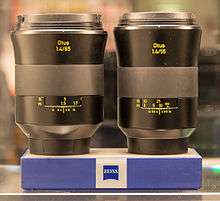
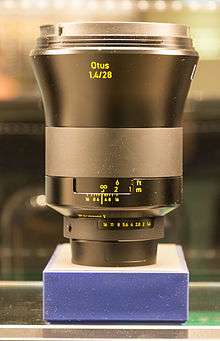
Zeiss produces manual focus Otus lenses for the Nikon F-mount and Canon EF mount, with electronic features equivalent to Zeiss ZF.2 and ZE lenses respectively. Otus lenses are complex no-compromise designs which Zeiss refers to as the "best in the world" in the normal lens and short telephoto categories. They cover the 35 mm format.
- Otus APO-Distagon T✻ 28mm ƒ/1.4
- Otus APO-Distagon T✻ 55mm ƒ/1.4
- Otus APO-Planar T✻ 85mm ƒ/1.4
Batis lenses
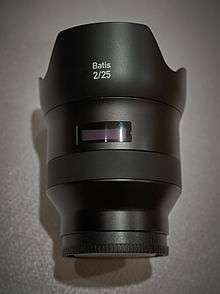
Zeiss produces autofocus Batis lenses for the Sony E-mount. Like Sony "FE" lenses, they cover the 35mm format.
- Batis Distagon T✻ 18mm f/2.8
- Batis Distagon T✻ 25mm f/2
- Batis Distagon T✻ 40mm f/2 Close-Focus
- Batis Sonnar T✻ 85mm f/1.8
- Batis Sonnar T✻ 135mm f/2.8
Loxia lenses
Zeiss produces manual focus Loxia lenses for the Sony E-mount. Like Sony "FE" lenses, they cover the 35mm format. The 35/2 and 50/2 are carried over from the existing ZM line.
- Loxia Distagon T✻ 21mm f/2.8
- Loxia Biogon T✻ 35mm f/2.0
- Loxia Planar T✻ 50mm f/2.0
- Loxia Sonnar T✻ 85mm f/2.4
Touit lenses
Zeiss produces autofocus Touit lenses for the Fujifilm X-mount and Sony E-mount. They cover the APS-C format.
Milvus lenses
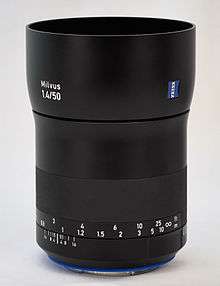
Zeiss produces manual focus Milvus lenses for the Nikon F-mount (ZF.2) and Canon EF lens mount (ZE), covering the 35mm format. The 15/2.8, 21/2.8, 35/2, 50/2, 100/2, and 135/2 are carried over from the previous Z-series (now referred to as Zeiss Classic).
- Milvus Distagon T✻ 15mm ƒ/2.8
- Milvus Distagon T✻ 18mm ƒ/2.8
- Milvus Distagon T✻ 21mm ƒ/2.8
- Milvus Distagon T✻ 25mm ƒ/1.4
- Milvus Distagon T✻ 35mm ƒ/1.4
- Milvus Distagon T✻ 35mm ƒ/2
- Milvus Distagon T✻ 50mm ƒ/1.4
- Milvus Makro-Planar T✻ 50mm ƒ/2
- Milvus Planar T✻ 85mm ƒ/1.4
- Milvus Makro-Planar T✻ 100mm ƒ/2
- Milvus APO-Sonnar T✻ 135mm ƒ/2
Super-rotator lenses
These are 360° tilt/shift lenses (based on Zeiss medium format lens designs) for 35 mm format including full-frame digital. Available mounts: Canon EF, Nikon F, Sony Alpha/Konica Minolta/Minolta A mount. Other mounts on request. Manual focus only, no electronics. Manufactured in Germany and Ukraine.
- Hartblei Superrotator Carl Zeiss Distagon T✻ IF 1:4.0 40 mm
- Hartblei Superrotator Carl Zeiss Planar T✻ 1:2.8 80 mm
- Hartblei Superrotator Carl Zeiss Makro-Planar T✻ 1:4.0 120 mm
NASA
Zeiss is currently in the process of designing the optical components for the James Webb Space Telescope set to replace the Hubble Space Telescope sometime in 2021.
A unique triplet of ultra-fast 50 mm f/0.7 lenses originally created by Zeiss for NASA's lunar program had the distinction of being reused by Stanley Kubrick in the filming of his historical drama Barry Lyndon. The period atmosphere of the film demanded that several indoor scenes be filmed by candlelight. To facilitate this, Kubrick had the lenses modified to mount onto a cinema camera and two of them subsequently further modified in separate ways to give wider angles of view.[28]
Smartphone lenses
Zeiss worked with Nokia, and later with Microsoft Mobile as they continued production of the Lumia series.[30] The Nokia 808 PureView features a lens custom-developed by Zeiss for its 1/1.2 inch sensor; as did its successor, the Nokia Lumia 1020. The Nokia N90 and Nokia N8 also used Zeiss optics. In 2017, Zeiss again provided optics for Nokia products through a collaboration with HMD Global,[24] beginning with the Nokia 8.[31]
ZA lenses
ZA ("Zeiss Alpha") lenses are designed and manufactured by Sony in Japan, and co-branded with the Zeiss name. Sony and Zeiss collaboratively set design and quality parameters for ZA lenses.
- A-mount ZA-lenses fit the Sony Alpha/Konica Minolta/Minolta A-mount system. They are fully dedicated autofocus lenses with eight electrical contacts, ROM-IC, and distance encoder ("(D)-function" to support ADI flash). All except for the DT lens are full-frame lenses.
- Sony α Carl Zeiss Distagon T✻ 1:2 24 mm ZA SSM (SAL-24F20Z)
- Sony α Carl Zeiss Planar T✻ 1:1.4 50 mm ZA SSM (SAL-50F14Z)
- Sony α Carl Zeiss Planar T✻ 1:1.4 85 mm ZA (SAL-85F14Z)
- Sony α Carl Zeiss Sonnar T✻ 1:1.8 135 mm ZA (SAL-135F18Z)
- Sony α Carl Zeiss Vario-Sonnar T✻ 1:2.8 16–35 mm ZA SSM (SAL-1635Z)
- Sony α Zeiss Vario-Sonnar T✻ 1:2.8 16–35 mm ZA SSM II (SAL-1635Z2)
- Sony α Carl Zeiss Vario-Sonnar T✻ DT 1:3.5–1:4.5 16–80 mm ZA (SAL-1680Z)
- Sony α Carl Zeiss Vario-Sonnar T✻ 1:2.8 24–70 mm ZA SSM (SAL-2470Z)
- Sony α Zeiss Vario-Sonnar T✻ 1:2.8 24–70 mm ZA SSM II (SAL-2470Z2)
- E-mount ZA-lenses are fully dedicated Sony E-mount autofocus lenses. Lenses carrying the E designation cover the APS-C format, while lenses designated FE cover 35mm format.
- Sony α Carl Zeiss Sonnar T✻ E 1:1.8 24 mm ZA (SEL-24F18Z)
- Sony α Zeiss Distagon T✻ FE 1:1.4 35 mm ZA (SEL-35F14Z)
- Sony α Carl Zeiss Sonnar T✻ FE 1:2.8 35 mm ZA (SEL-35F28Z)
- Sony α Zeiss Planar T✻ FE 1:1.4 50 mm ZA (SEL-50F14Z)
- Sony α Carl Zeiss Sonnar T✻ FE 1:1.8 55 mm ZA (SEL-55F18Z)
- Sony α Zeiss Vario-Tessar T✻ FE 1:4 16–35 mm ZA OSS (SEL-1635Z)
- Sony α Carl Zeiss Vario-Tessar T✻ E 1:4 16–70 mm ZA OSS (SEL-1670Z)
- Sony α Carl Zeiss Vario-Tessar T✻ FE 1:4 24–70 mm ZA OSS (SEL-2470Z)
In addition to these Sony collaboration lenses, Zeiss offers Touit (APS-C format), Loxia (35mm format) and Batis (35mm format) lenses for E-mount.
Other products
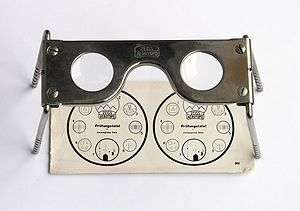
Zeiss offers a wide range of products related to optics and vision. These include camera and cine lenses, microscopes and microscopy software, binoculars and spotting scopes, eyeglasses and lenses, planetariums and dome video-systems, optical sensors, industrial metrology systems and ophthalmology products. Even video glasses belong to the product range. In the summer of 2012, the new video glasses Cinemizer OLED were to come on the market. In addition to the viewing of 2D and 3D movies, it will be possible to play computer games when fitted with the equipment.[32]
The largest part of Carl Zeiss AG's revenue is generated by its Semiconductor Manufacturing Technologies division, which produces lithographic systems for the semiconductor industry, as well as process control solutions (electron microscopes, mask repair tools, helium ion microscopes).[33]
Sports Optics
Carl Zeiss Sports Optics division produces rifle telescopic sights, spotting scopes, binoculars, and distance measuring devices for outdoors enthusiasts. The three main product lines are the Conquest line, which is manufactured in Germany and assembled in the United States, and Victory line, which is produced entirely in Germany, and the Terra line, which is made in Asia.
Since 2019 the following Zeiss sport optics products series are in production:[34]
Binoculars
Spotting scopes
- Dialyt
- Conquest Gavia
- Victory Harpia
Medical Solutions
This branch of Carl Zeiss is managed by Carl Zeiss Meditec. It is divided in Ophthalmology/Optometry, Neurosurgery, ENT, Spine, P&R, Dentistry, Radiotherapy and Gynecology.
Vision Care
Carl Zeiss Vision Care division develops, manufactures and distributes ophthalmic lenses, optical coatings, and dispensary technologies and services. Zeiss is known for ophthalmic lenses made from high refractive index glass, allowing stronger prescription lenses to be thinner.
Their progressive lens ZEISS Progressive Individual has won multiple awards including the OLA awards in 2009 presented at Washington, D.C.[44] and the VisionPlus or VP Awards in 2014 at Mumbai, India.[45]
Industrial metrology
Zeiss Industrial Metrology specializes in high-accuracy measurement systems, including coordinate-measuring machines (CMMs), computed tomography measurement machines (non-medical), optical measuring equipment, metrology software and measurement sensor systems. The Industrial Metrology subsidiary provides this equipment to a wide range of manufacturing facilities worldwide.[46]
Zeiss has manufactured coordinate measuring machines since 1919,[47] offering very basic manually operated CMMs. In 1973, Zeiss introduced the UMM 500, using a Zeiss sensor system and Hewlett-Packard computer.[48] Zeiss has since vastly improved and diversified their product line and now feature many high accuracy CMMs, the Metrotom,[48] a CT x-ray scanning measuring machine, with the ability to quickly and completely measure a part in 3 dimensions without ever touching the part, and the O-INSPECT,[48] a fully optical measurement machine.
Zeiss is currently a member of the International Association of CMM Manufacturers (IACMM).[48]
Many of the sensor systems produced by Zeiss are proprietary technologies, using technologies exclusively patented by Zeiss, and therefore can offer better accuracy and repeatability than its competitors.[49]
Zeiss was the first manufacturer of coordinate measurement machines to introduce computer numerical control (CNC) technology to a coordinate measurement machine and was the first company to offer CNC stylus changer capability for these machines.[48]
Semiconductor Manufacturing Technology
Carl Zeiss SMT systems for DUV and EUV electromagnetic radiation are used in chip-lithography machines for focusing the extremely short wavelengths.[50] Together with the company ASML and its subsidies and partners Zeiss is the sole supplier of the lithography systems that are able to manufacture core layers of the latest semiconductor chips.
Microscopes
Zeiss offers different types of microscopes:
Fire doors
The name Zeiss Ikon can also be found in old cinemas, on fire shutters on the projection windows. These had heat fuses that melted and dropped the shutter over the hole if the film caught fire in the projection booth.
References
- Executive Board of Carl Zeiss AG
- "Financial Highlights IFRSs". www.zeiss.com. Retrieved 18 December 2019.
- Krech, Eva-Maria; Stock, Eberhard; Hirschfeld, Ursula; Anders, Lutz Christian (2009). Deutsches Aussprachewörterbuch [German Pronunciation Dictionary] (in German). Berlin: Walter de Gruyter. p. 1066. ISBN 978-3-11-018202-6.
- Wells, John C. (2008), Longman Pronunciation Dictionary (3rd ed.), Longman, ISBN 9781405881180
- "The Carl Zeiss Story – 20 Years of Reunification at Carl Zeiss". www.zeiss.com. Retrieved 3 July 2019.
- "ZEISS Group – International Segments and Sites". www.zeiss.com. Retrieved 3 July 2019.
- "ZEISS Group – Company History Overview and Sources". www.zeiss.com. Retrieved 3 July 2019.
- "Zeiss". www.smecc.org. Retrieved 29 November 2017.
- 150 Years of Hensoldt Archived 24 May 2011 at the Wayback Machine
- Gruner, Wolf (2006). Jewish forced labor under the Nazis: economic needs and racial aims, 1938-1944. Cambridge University Press. ISBN 0-521-83875-4. Archived from the original on 6 December 2019. Retrieved 12 September 2011.
- Klemperer, Victor (2000). To The Bitter End: The Diaries of Victor Klemperer 1942-45. Phoenix. ISBN 0-7538-1069-7.
- Archived 10 August 2007 at the Wayback Machine
- König, Karsten (21 July 1998). "A Short Review On History Of Optics In Jena". Institute of Anatomy II, University of Jena. Archived from the original on 30 September 2007. Retrieved 19 February 2008.
- "A passion for politics and a head for business". Optics & Laser Europe. 1 January 2002. Retrieved 19 February 2008.
- What you should know about Carl Zeiss Sports Optics GmbH Archived 24 January 2009 at the Wayback Machine
- "A new experience in vision". Zeiss Vision Care. Retrieved 16 August 2018.
- "Company History Abstract: The 21st Century". Carl Zeiss AG. Retrieved 16 August 2018.
- Dick Whitney, Curator. "American Optical History" (PDF). Optical Heritage Museum. Retrieved 16 August 2018.
- Xiang, Liu (3 July 2013). "Carl Zeiss Officially Renamed To Zeiss". GSM Insider. Archived from the original on 29 September 2013. Retrieved 3 July 2013.
- "Zeiss expands metrology portfolio with GOM acquisition". optics.org. 11 April 2019. Archived from the original on 31 July 2019. Retrieved 5 January 2020.
- History of Camera Lenses from Carl Zeiss — 1935 — Alexander Smakula develops anti-reflection coating
- "Lens Coating – ZEISS United States". www.zeiss.com. Retrieved 29 November 2017.
- "Nettar – Camera-wiki.org – The free camera encyclopedia". camera-wiki.org. Retrieved 29 November 2017.
- "Nokia and Zeiss brands reunite for the Android era". Retrieved 29 November 2017.
- https://www.dpreview.com/news/3430444458/zeiss-announces-full-frame-compact-with-fixed-35mm-f2-lens
- Hasselblad Historical
- Carl Zeiss Camera Lens News 29, September 2008 Archived 2 June 2010 at the Wayback Machine (retrieved 3 October 2008)
- "Untitled Document". www.visual-memory.co.uk. Retrieved 29 November 2017.
- "Nokia 808 PureView – Full phone specifications". www.gsmarena.com. Retrieved 29 November 2017.
- "Creating a PureView with ZEISS: Lumia Imaging Innovation". Microsoft Windows Blog, 25 September 2014. Retrieved 23 August 2017
- "Counterclockwise: Nokia genetics and the features it evolved". Retrieved 29 November 2017.
- 3D-capable video glasses with Head Tracker for Games (German), Golem. Retrieved 3 March 2012.
- Slides of Half-Year Press Conference for fiscal year 2007/08, 29 May 2008 Archived 9 December 2008 at the Wayback Machine
- Zeiss optical factory in Wetzlar
- Zeiss Conquest HD 8x42 binoculars video review
- Zeiss Victory HT binoculars
- Zeiss Victory SF binoculars test
- Zeiss Victory RF binoculars
- Zeiss entry level optics
- Zeiss Conquest V4
- Zeiss Conquest V6 rifle scopes
- Zeiss Victory HT 3-12x56 reticle subtensions
- Zeiss Victory V8 rifle scopes
- "minews – mivision | Bringing Optics into Focus". mivision. 20 January 2010. Retrieved 2 November 2015.
- "VisionPlus Awards". Vp-awards.com. Archived from the original on 18 March 2014. Retrieved 2 November 2015.
- "ZEISS Industrial Metrology Homepage". www.zeiss.com. Retrieved 29 November 2017.
- Carl Zeiss, Industrial Metrology – 90 Years in Industrial Metrology Archived 27 July 2011 at the Wayback Machine
- "ZEISS Industrial Metrology Homepage". www.zeiss.com. Retrieved 29 November 2017.
- "ZEISS Industrial Metrology Homepage". www.zeiss.com. Retrieved 29 November 2017.
- Archived 1 February 2014 at the Wayback Machine
External links
| Wikimedia Commons has media related to Zeiss. |